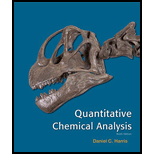
a)
Interpretation:
The ways to measure k and resolution has to be given.
Concept Introduction:
Resolution:
The resolution can be calculated using the formula as given below,
Where,
Retention factor:
The time that is necessary to elute that peak minus the minimum possible time for the travel of unretained solute through the column is called as retention factor. The retention factor is calculated using the equation,
Where,
b)
Interpretation:
The three methods for measuring
Concept Introduction:
Reversed-phase chromatography:
One of the most common mode of HPLC is the reversed-phase chromatography. In reversed-phase chromatography, the mobile phase is more polar and the stationery phase is nonpolar or weakly polar. The solute is more rapidly eluted from the column in reversed-phase chromatography as the mobile phase is polar. Less polar mobile phase (solvent) has a high mobile phase strength.
This method is adequate to separate mixtures of low molecular mass.
c)
Interpretation:
The three methods for measuring
Concept Introduction:
Hydrophilic interaction liquid chromatography (HILIC):
This is other technique to separate small polar compounds on stationary phase with polar nature. It has reported as variant of normal phase liquid chromatography, but the mechanism of separation in HILIC is more complicated than in normal phase liquid chromatography. Bare silica or silica gels modified with polar functional groups are generally used as HILIC stationary phase.
d)
Interpretation:
The
Concept Introduction:
The formula,
Want to see the full answer?
Check out a sample textbook solution
Chapter 25 Solutions
Quantitative Chemical Analysis
 ChemistryChemistryISBN:9781305957404Author:Steven S. Zumdahl, Susan A. Zumdahl, Donald J. DeCostePublisher:Cengage Learning
ChemistryChemistryISBN:9781305957404Author:Steven S. Zumdahl, Susan A. Zumdahl, Donald J. DeCostePublisher:Cengage Learning ChemistryChemistryISBN:9781259911156Author:Raymond Chang Dr., Jason Overby ProfessorPublisher:McGraw-Hill Education
ChemistryChemistryISBN:9781259911156Author:Raymond Chang Dr., Jason Overby ProfessorPublisher:McGraw-Hill Education Principles of Instrumental AnalysisChemistryISBN:9781305577213Author:Douglas A. Skoog, F. James Holler, Stanley R. CrouchPublisher:Cengage Learning
Principles of Instrumental AnalysisChemistryISBN:9781305577213Author:Douglas A. Skoog, F. James Holler, Stanley R. CrouchPublisher:Cengage Learning Organic ChemistryChemistryISBN:9780078021558Author:Janice Gorzynski Smith Dr.Publisher:McGraw-Hill Education
Organic ChemistryChemistryISBN:9780078021558Author:Janice Gorzynski Smith Dr.Publisher:McGraw-Hill Education Chemistry: Principles and ReactionsChemistryISBN:9781305079373Author:William L. Masterton, Cecile N. HurleyPublisher:Cengage Learning
Chemistry: Principles and ReactionsChemistryISBN:9781305079373Author:William L. Masterton, Cecile N. HurleyPublisher:Cengage Learning Elementary Principles of Chemical Processes, Bind...ChemistryISBN:9781118431221Author:Richard M. Felder, Ronald W. Rousseau, Lisa G. BullardPublisher:WILEY
Elementary Principles of Chemical Processes, Bind...ChemistryISBN:9781118431221Author:Richard M. Felder, Ronald W. Rousseau, Lisa G. BullardPublisher:WILEY





